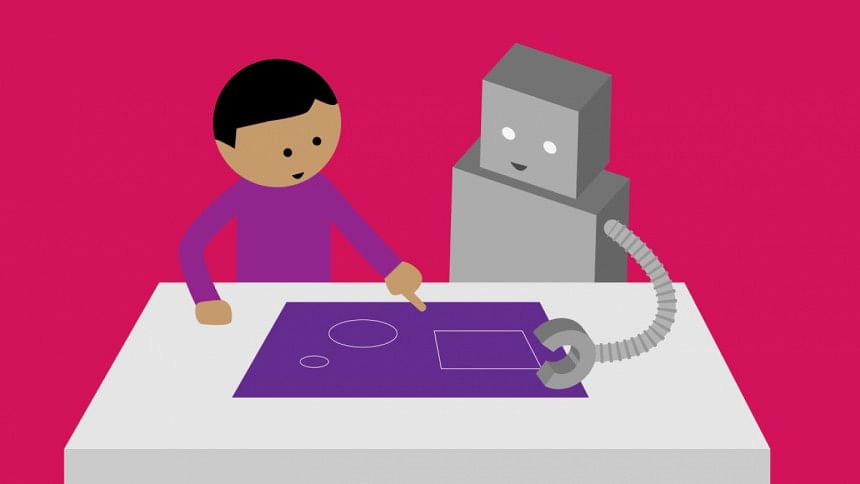AI in RMG: What's in store for Bangladesh?

As I began to write down my thoughts on the topic of Artificial Intelligence (AI), I instinctively turned to the biggest AI engine: Google! Its powerful, AI-enabled search engine led me to the Deloitte Insights website. Interestingly, on the website itself, a neat little chatbot in the bottom corner of my screen (called Ask Scout) prompted me to ask questions. It even listed a few suggested questions for me. I instinctively chose the first option it had suggested: What is Artificial Intelligence? And I got a prompt reply as well: "Artificial Intelligence (AI) refers to computer systems that are able to perform tasks that normally require human intelligence. There is a distinction between artificial intelligence, a field with hazy conceptual boundaries, and the technologies that employ it, the cognitive technologies. These include machine learning, computer vision, speech recognition, natural language processing and robotics."
I turned to Amazon Alexa sitting near my study table and asked Alexa the same question through a voice command. Again, promptly came the reply.
It is this pervasive ability of AI that makes it a technology that is "real" and not just some "science fiction" stuff. Artificial Intelligence is already a big part of how we live and how we work.
There are concerns that as AI technology advances, it will make most human-filled jobs obsolete and make millions jobless. These fears are not completely baseless. In the past, several reports from ILO and such organisations as well as top media outlets made headlines like, "Robots are coming for our jobs", or "Automation will destroy jobs and we are not ready for it" etc.—which created alarm in the minds of most people.
While these are valid concerns, one needs to take a well-rounded view of the entire picture. There may be another side to the story which has yet to make headlines. A deeper understanding and analysis are needed before we jump to any "scary" conclusions. Any new technological advancement, while it renders some jobs redundant, also brings in its wake new jobs that did not exist before. The question is whether the creation of new jobs will match the vanishing of old jobs and at what rate the new jobs will be filled up by "newly acquired skill sets" or "talent"—or if we will be able to keep pace with the "skill gap" and "training" required to acquire new skills.
Before we go into that discussion, let's first look at how AI is finding application in the apparel manufacturing world. Several functions and processes in textile and apparel industry make a strong case for AI application. AI's powerful vision and image recognition system can easily help in identifying and grading textile fibres. Identification of fabric defects can be done much faster and more accurately using AI. In terms of the most important element of design "colour", AI can enable an accurate prediction of dye recipe, process control during dyeing, automated dispensing of dyes and even in final colour evaluation. When it comes to garment manufacturing, AI can enable accurate performance during cutting, spreading and sewing. CAD and patternmaking, production planning and control, shop floor control systems—all these can be performed at a much higher level of productivity and accuracy with AI technology.
On the buying side, AI can help predict trends and customer preferences. Many such applications are already in use by major online retailers. As you make a purchase on Amazon, it predicts and suggests products that you may be interested in buying based on data from your previous buying patterns, thus creating a personalised shopping experience. For merchandisers and product designers, AI helps to predict what is trending and what customer preferences are in terms of colour, design, size, price points, etc.
There is undeniably a case for AI and its application in the apparel industry. There is also evidence that AI application and automation will make a lot of jobs done by humans redundant. Will the transformation to new technologies only take away jobs, and not create new ones?
Let's take a closer look at what the data sources tell us. Recent reports from reputed consulting firms like Deloitte and Cognizant suggest that AI and automation will create many more new jobs that did not exist before. Cognizant goes on to predict 21 new job types that the new technology will bring forth. A Gartner report says that AI will generate 2.3 million jobs, exceeding the 1.8 million that it will remove.
AI needs humans to train it. Cobots and Robots will require humans to make sure that they work smoothly. Some of the new job titles that will emerge are likely to be "bot trainer", "bot farmer", "bot curator". The low-level repetitive tasks will be done far more productively and accurately by AI and machines. Higher-order skill jobs will continue to be performed by humans.
Technology like AI and automation will augment human capability. It will not replace them. It will not compete with them. Rather, it will complement them. Jobs that machines will take over are those that are better performed by machines—precision, coordination, rate control, strength, repetitive tasks, scalable data processing, etc. Humans will still be needed to support the machines to do their jobs by performing the higher-order skilled tasks—problem solving, selective attention, critical thinking, handling ambiguity, judgment, empathy, etc.
In the context of apparel manufacturing, for example, the need to run the control software of the automation equipment and robotics can create more high-wage jobs compared with the existing low-wage manufacturing jobs. Hence, the workers can acquire these skills and earn high wages.
Newer skill-sets would need to be acquired to fulfil the roles in the new way of working in which AI and machines will be assisted by humans. There will be an increasing need for technicians, machinists, digital patternmakers, digital product simulation experts and machine and robot programmers, while the workforce will need to be equipped with new skills such as preventive maintenance of machines, technical troubleshooting and supervision of machines.
The need of the hour, therefore, is to relook at how we as an industry approach AI and automation. One view is to approach it from the negative side in terms of job loss, costs of automation vs low-skilled labour cost advantage. The other view is to look at the positive side of embracing technology in terms of total value added to the end customer, redesigning the job roles and upskilling the existing workforce to take up higher-level roles and hence get high-paid jobs.
The world is moving towards further technological advancement and we need to keep in step with it. We should not approach digital technology as a threat but rather as an opportunity for progress and growth. The entire apparel industry of Bangladesh and the nation can move to the next level of prosperity if we rise to the occasion. Let's not get stuck in the vicious cycle of being a nation known for "low-paid, low-skilled" work, but rather move up the value chain and provide higher value to the end customers and demand a high pay for a higher level of skills. Let's work towards re-training our existing workforce for the future skills.
Mostafiz Uddin is the Founder and CEO of Bangladesh Apparel Exchange (BAE) and Bangladesh Denim Expo. He is the Managing Director of Denim Expert Limited. Email: [email protected].










Comments